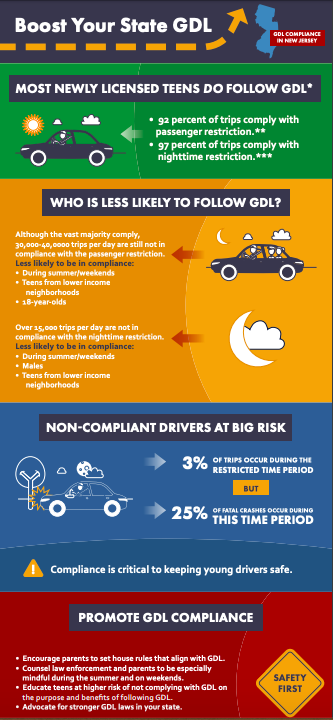Why States Need Stronger Licensing Policies to Reduce Young Driver Crashes
Motor vehicle crashes are one of the most significant public health threats facing our country’s adolescents. They are the leading cause of death among 15- to 19-year-olds, accounting for 1 in every 4 deaths and more than 300,000 emergency department visits each year. Although some experts call for more driver education, law enforcement and motor vehicle technology focused on safety to reduce teen driver crashes, these recommendations may be too vague to provide guidance for meaningful action. Neither driver education nor law enforcement have been shown to reliably improve driving safety among young drivers, and it will take decades for motor vehicle safety technologies to be widely available. Instead, we should modernize young driver licensing policies as a guaranteed way to reduce crash-related fatalities and injuries in many U.S. states. This can be done by strengthening Graduated Driver Licensing (GDL) programs across the country.
GDL is an experience-based method for young drivers to earn driving privileges that are introduced in phases. In the mandatory learner license stage, adolescents must be accompanied by an experienced adult driver—usually a parent. After a lengthy period of supervised  driving, novices ‘graduate’ to an intermediate license stage that allows driving without an adult but includes restrictions to keep them out of high-risk driving situations, such as driving at night or with multiple peer passengers. GDL also offers newly licensed teens the opportunity to gain needed on-road experience before driving under more challenging conditions.
driving, novices ‘graduate’ to an intermediate license stage that allows driving without an adult but includes restrictions to keep them out of high-risk driving situations, such as driving at night or with multiple peer passengers. GDL also offers newly licensed teens the opportunity to gain needed on-road experience before driving under more challenging conditions.
Dozens of studies have documented the crash-reducing benefits of GDL for 16-year-olds and the benefits of GDL for 17-year-old drivers in states with well-structured licensing systems. This research includes naturalistic studies that utilize in-vehicle technologies to show actual driving conditions and behaviors in the moments before a crash, as well as analyses of individuals’ licensing and crash data that depict in detail how crash risk changes during the first few years of licensure.
Taking Action to Further Reduce Crashes
Unfortunately, these findings have not been translated into enhancements to most states’ GDL systems. Although the federal government has incentive grants that are awarded to states if they have a set of GDL restrictions that meet certain criteria, no states have qualified for them. Here are improvements that remain needed in most states:
- Enact a Learner License Stage Lasting 12 Months. This will ensure beginner drivers have adequate opportunity to safely acquire a generous amount of parent-supervised driving practice in a wide-range of environments and conditions. Although some policymakers worry that extending the time parents spend supervising driving practice is a burden, parents of teens who have recently completed a mandated 12-month learner period overwhelmingly support that requirement.
- Enact a Nighttime Protection for Intermediate Licenses that Begins at 9 p.m. or 10 p.m. and Lasts at Least Six Months. Young drivers’ nighttime crashes are heavily concentrated well before midnight, with 50% to 60% occurring between 9 p.m. and 11 p.m. This is why a 9 p.m. or 10 p.m. starting time for requiring adult accompaniment for newly licensed drivers has long been recommended by traffic safety experts. However, only 13 states currently begin their night driving protection at 10 p.m. or earlier, 13 others begin at 11 p.m., 23 at midnight or later and Vermont has no nighttime limit at all.
- Enact a Passenger Provision that Allows No More Than One Peer Passenger and Lasts at Least Six Months. Most states have done a good job of setting passenger limits during the intermediate license stage that align with the evidence about passenger effects on young driver risk. Nonetheless, five states have no limit on carrying young passengers during this stage of driving, even though carrying three or more young passengers more than quadruples the risk of a young driver fatality.
Policymakers may be reluctant to take action for the following reasons: constituent unhappiness, curtailing teenagers’ need to drive to school or work, and overburdening law enforcement. However, research has dispelled some of these primary concerns and shows that the vast majority of teenage drivers readily comply with these three essential GDL provisions and that parents soundly approve of them.
Although the number of crash fatalities in the U.S. among adolescents has markedly decreased over the last few decades, a recent 14% increase from 2014 to 2016 underscores the critical need for policymakers to take action.
Learn how to advocate for better GDL policy.
Dr. Allison E. Curry is a senior scientist and director of Epidemiology and Biostatistics at the Center for Injury Research and Prevention and Children’s Hospital of Philadelphia. Dr. Curry’s studies on GDL include the first rigorous evaluation of the effects of a Graduated Driver Licensing decal provision on the rate of teen compliance, enforcement, and crash rates and several epidemiologic studies that directly inform state-level implementation of GDL policy, including consideration of whether GDL should be extended to older novice drivers.

